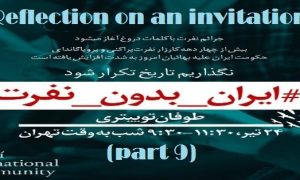In current solar month of Tir, the deviant cult of Baha’ism runs a campaign called “#Iran- without-hate” by some prominent elements of Baha’ism.
Thursday, Tir 24, 1400 S.H., July 15, 2021 A.D.
The universal community of Baha’i ran a Twitter campaign called “ایران-بدون-نفرت#” [# Iran-without-hate] today Thursday night, Tir 24th to finish hate and propaganda of the Iranian system of government against the Baha’is
In the 9th part of the topic of the reason for the Iranian people to hate the deviant cult of Baha’ism, we will consider and investigated the the most important torturers working in SAVAK.
آنچه در ادامه می خوانید
The Baha’i torturer! SAVAK in hands of the Baha’is

In a strange measure after forming the Islamic Revolution in Iran and after some heads of Baha’is being captured due to spying, the Baha’ism organization issued a statement stating the vain claiming for not meddling with policy and pretending to be oppressed and rejected each relationship with the Pahlavi regime.[1]
However, it is interesting to be known that Baha’ism has tried to reject its all betrayals and tyrannies against the liberal people of Iran while the pages of history testify the sedition and tyranny of the Baha’ism organization against the Iranian people. Consequently; in this article, we are trying to introduce several famous Baha’i people of the deviant Baha’i organization, SAVAK and the Baha’i torturers:
One of the famous Baha’i torturers of SAVAK was Fereydoun Tawangari known as Arash. He was born in 1329 S.H. in Tehran city and his marriage document has been registered in the Baha’is assembly office of Tehran dated 1357/5/14. Earlier 1352 he became in charge of operation section measure and tortured men and women. In 1354 S.H., he became the operation leader. He has been known as the most violent investigator in the common committee.[2]
One of the other Baha’i torturers of SAVAK was Colonel Zibaee. It has been reported for some people to be killed under his fist and kick. People hated Colonel Zibaee too much that attacked his house on the eve of the victory of Revolution and made his house fire in 1357.[3] One of the other Baha’i high-ranking managers of SAVAK was Colonel Shirvanlou. He followed spying activities and fighting against people when he was the military commander. He was busy working in in SAVAK while he was retired. He was so famous in the court and could make his son, Firouz Shirvanlou, be employed in SAVAK.[4]
Conclusion
The Baha’ism cult excommunicates every body who acts against its principles having organization system. According to Hussein Fardoust, the presence of the Baha’i elements in the political and security position (contrary to the Baha’i leaders’ orders) has been done allowed by the universal house of justice: “One day, I asked lieutenant general Saniee: How have you taken over the political job? He answered: It has been asked from Akka and we are allowed to take over such exceptional and important careers.[5]”
According to history, Baha’ism that has shouted the slogan of being oppressed has tyrannized against the Iranian people as long as it could. Although being oppressed is one of the policies and strategies of Baha’ism[6] and even it has introduced defending itself as indecent and absence[7], it has proved that it has tyrannized in practice like the greatest criminals during history.
[۱] Refer to Zahed Zehedani, Baha’ism in Iran, Bija: The center for the Islamic Revolution documents, 1381, pp. 307-317.
[۲] Qasem Hassan Pour, The torturers tell, p. 13.
[۳] Ahmad Allah Yari, Baha’is in Pahlavi era, the half undercover, Vol. 31, pp. 138-139.
[۴] Ibid
[۵] Hussein Fardoust, the emergence and falling of Pahlavi kingdom, Bija: Ettela’at publishing house, 4th, 1380 S.H., Vol. 1, p. 375.
[۶] Refer to Ishraq Khawari, the heavenly food, Bija: the national institute of the faith press, 129 Badi’a, Vol. 4, pp. 349-350.
[۷] Refer to J. Esslement, Bahaullah and the new era, Brazil: Manshourat Darunnashr Al-Bahaiyah, 1998 A.D. pp. 190-191.






